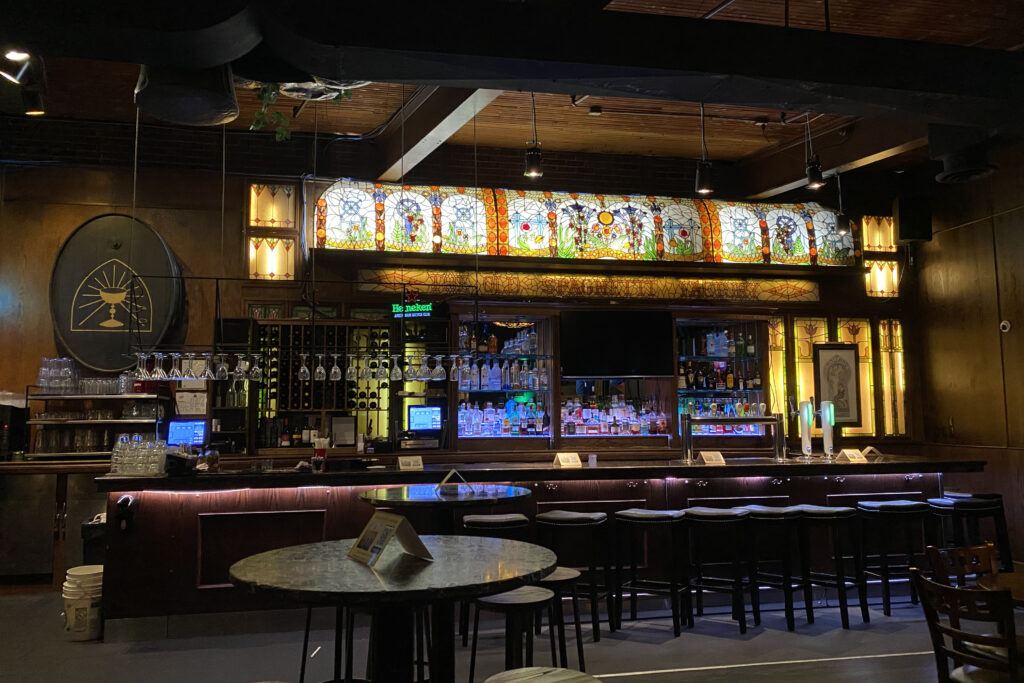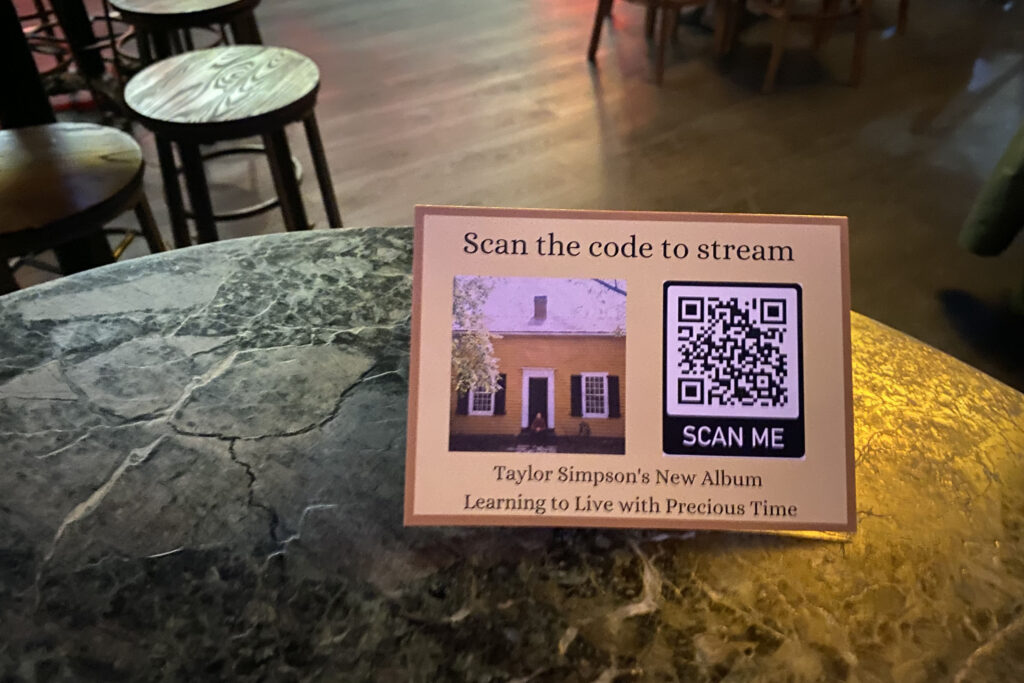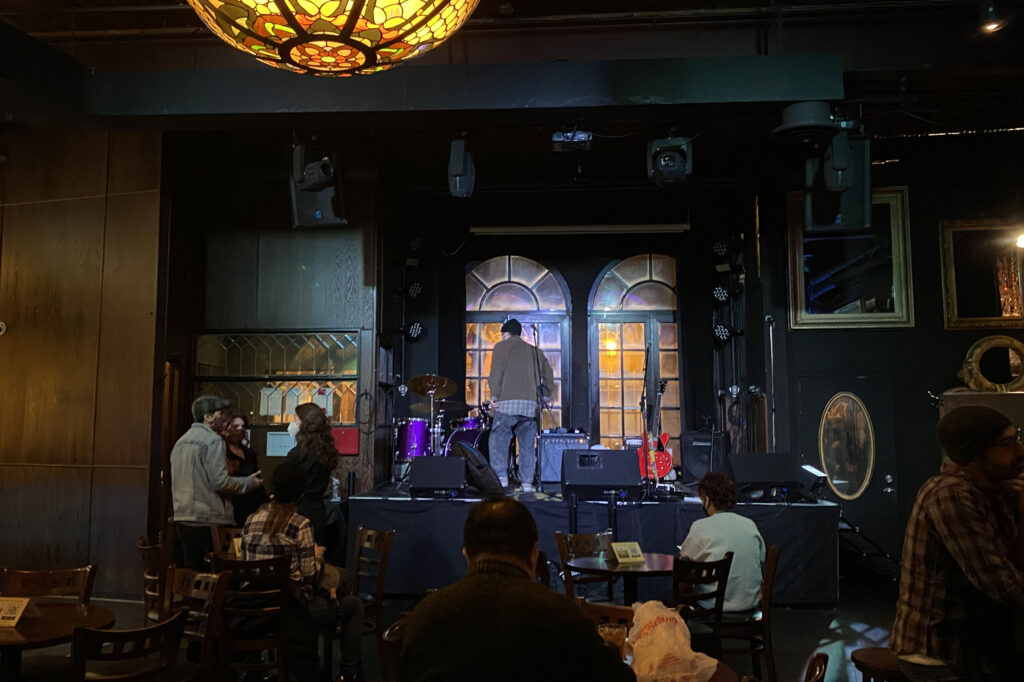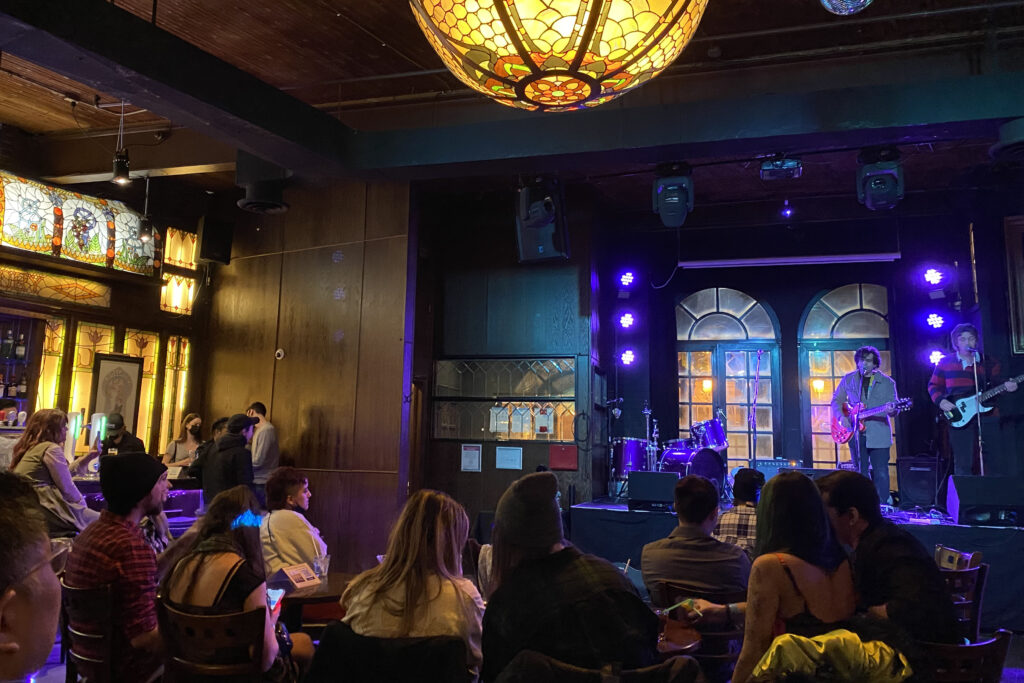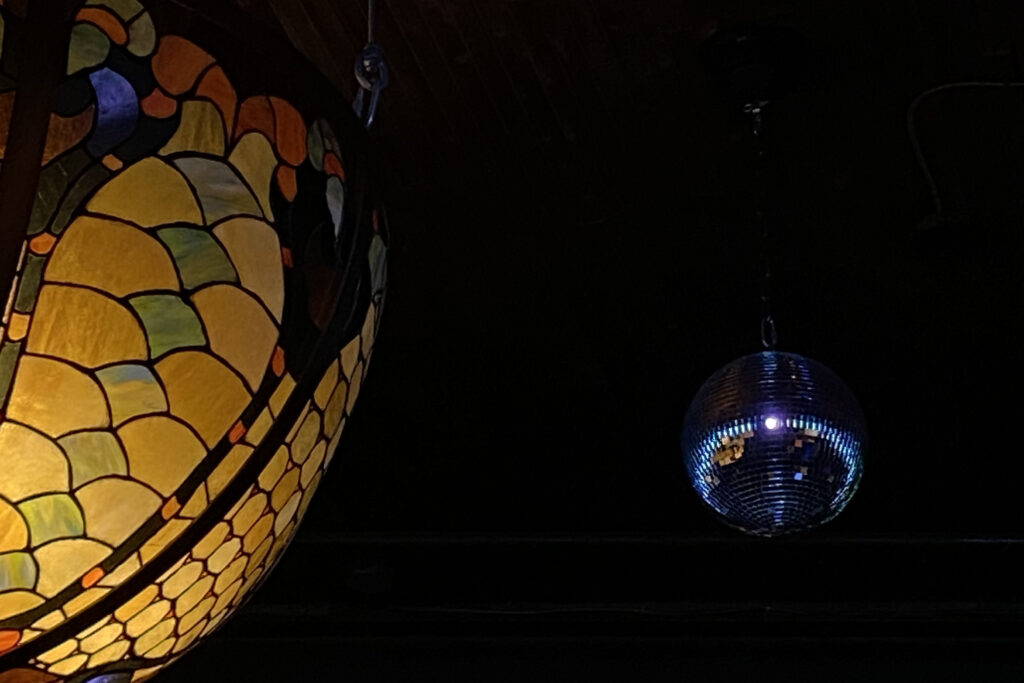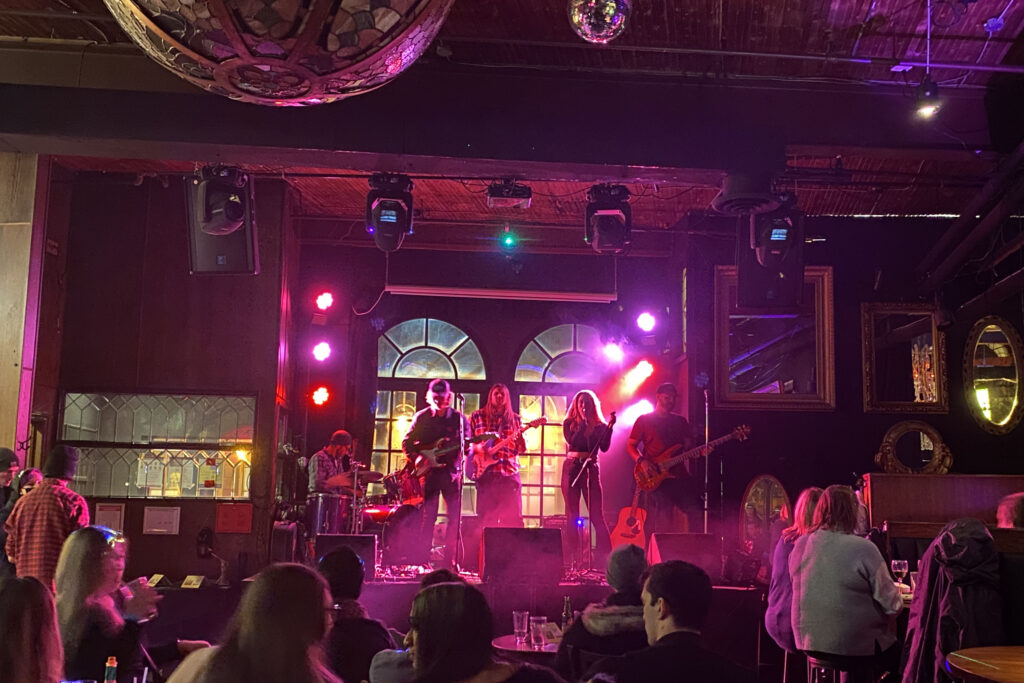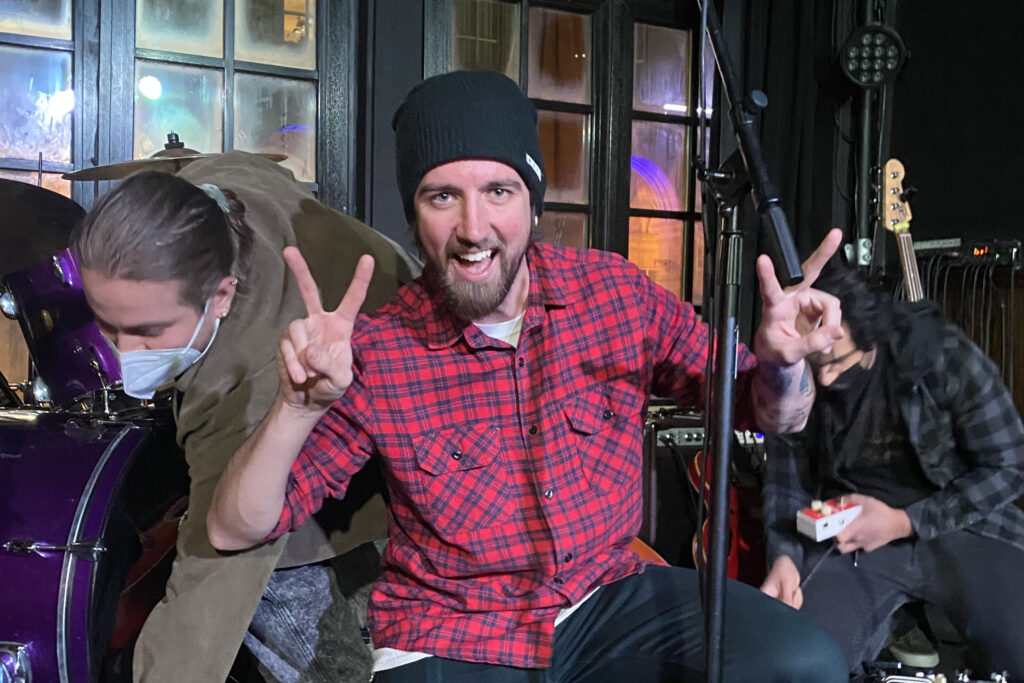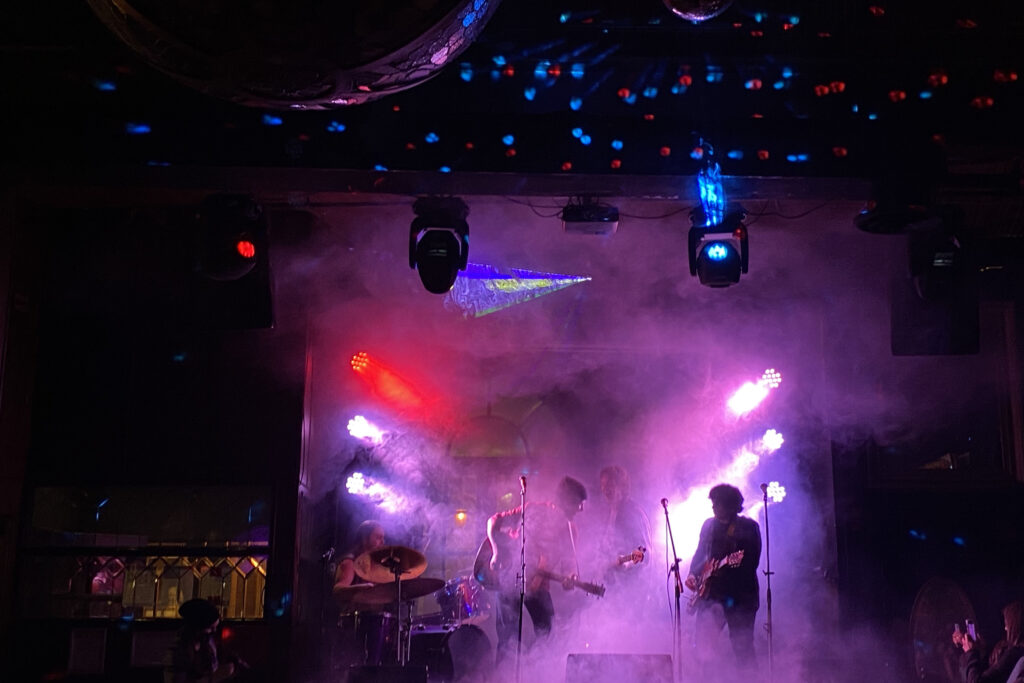By Stephanie Beattie
Vibrant red and purple stage lights bounced off the stained-glass windows all around the room as the Toronto-based singer-songwriter Taylor Simpson strummed his guitar. During his album release show at Bar Cathedral on Feb. 23, the audience rose from their tables to dance in front of the stage. Fans sang his lyrics back to him under the reflections of a silver disco ball spinning slowly from the ceiling.
Simpson, 28, said the experience felt euphoric. “I had a drug addiction problem, and it’s funny, I feel like this kind of replaced that in my life – like I’m chasing the high of performing.”
The human connection between the artist and the audience seemed “surreal” to Simpson because it’s been gone for two years. The release of his album, Learning to Live with Precious Time, was a huge step forward in his career, although the process of creating the album did not come easily.
With recording studios, rehearsal spaces and live music venues either closing their doors temporarily or disappearing completely, much of Simpson’s career shifted online at the start of the pandemic. According to MRC data published in Billboard, Canadians streamed more music online, while physical and digital album sales decreased in 2021. To combat this, Simpson continues to build his presence on social media as he begins to navigate the reopening of performance spaces.
Simpson hit the recording studio just before the pandemic began. Beneath the floating ceilings of MH Studio’s basement, Simpson worked on demos and tracks with his producer. “We were just about to start vocals, and that’s when the world decided to collapse on itself and COVID destroyed everything,” Simpson explained. After two and a half years, the album was finally released on Jan. 28.
As Ontario slowly reopens, live music venues like Bar Cathedral have shifted to offering full in-house production systems for hybrid concerts. Artists can download the livestream audio and video of the stage from these shows and turn them into new projects. Simpson’s performance, for example, can now be streamed.
The space itself at Bar Cathedral enhances the experience for the artist performing. The venue’s director, Adam Germain, explained, “It’s very neat because the view from the stage is almost more exquisite than the view from the audience because you get to actually really take in the arches that are in the back and the full stained-glass composition of the walls.”
It wasn’t always stained-glass windows that surrounded Simpson during his performances, though. Simpson performed his music in his Etobicoke bedroom during the pandemic. Surrounded by walls covered in sound-absorbing panels, black and white band posters and a vibrant floral tapestry hanging alongside plastic vines, his stage was set. “It was very interesting being in this room for the most part, or maybe my living room to change sceneries, and just playing songs in front of my phone,” Simpson said.
Virtually, he was not alone. Simpson said he played a lot of livestream shows throughout the pandemic on streaming platforms like Twitch and Instagram Live. He engaged with his fans through a screen, but clapping hand emojis in a chat could not compare to a live audience. During this time, an initiative called Star Pow-R asked him to perform in a folk-themed livestream with three other musicians. The stream raised money for local businesses chosen by each artist. Dawn Van Dam, president of Canyon Entertainment Group, founded Star Pow-R after not being able to attend the Juno Awards in 2020, realizing the pandemic would affect smaller artists long-term. “It’s hard because you couldn’t sit there and feel the live energy exactly, but a live screen was the best that we could do,” Van Dam said.
In a separate livestream, Simpson raised almost $500 for the Centre for Addiction and Mental Health (CAMH). He said independent artists have a difficult time making money for themselves since platforms like Spotify only pay around $0.003 per stream. Simpson works at a restaurant in Mississauga, but his only other income is revenue from ticket sales from in-person shows, which are finally starting to come back. Livestreams didn’t bring in cash, but they did remind Simpson of the intimacy of the folk genre between musician and audience.
“There’s just a moment that you make as an artist with the audience, and vice versa with the audience watching the artist, where you’re just connected on a deeper level than ever you could with a screen or just the recording.” It’s about storytelling really, he said.
Storytelling was a part of what first attracted Simpson to folk music. He spent most of his childhood with his two uncles, Shane and Rick. Both were musically inclined and played guitar with Simpson when he was five or six years old. Their visits together were often spent playing acoustic guitar, which eventually inspired Simpson to pick up the instrument. He couldn’t afford lessons, so he taught himself. Years later, he attended the independent songwriting and performance program at Seneca College, making music connections and learning how to transform his inspirations into a career.
Today, Simpson is mainly inspired by Dallas Green, the lead singer of City and Colour. Both Simpson and Green explore similar musical genres fueled by more emotional songwriting. Simpson said he writes melodies before lyrics. His creative process emerges as he walks through parks in Etobicoke and observes the nature around him. The sound of waves hitting the shore and the shuffling of leaves on branches above him inspires new melodies in the form of a quick hum. Simpson said he lifts his phone and records his voice, later turning his sound into a story.

Simpson’s debut album, Learning to Live With Precious Time, is a concept album based on his personal experiences and life journey. (Stephanie Beattie/XSJ)
Often pulling from experiences with his own mental health, Simpson’s writing explores his previous trauma with the loss of his parents and previous drug abuse, providing a sense of honesty in his music. Since his return to live music, Simpson is able to reach his audience on a deeper level by performing his new album on a real stage. He said he “wears his heart on his sleeve,” and hopes to extend the storytelling experience to wider audiences in the future. “I just want to play shows and whatever capacity that looks like, I’m going to do it,” he said.

